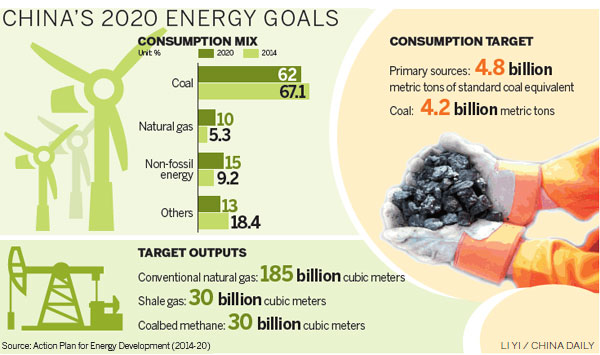 Top 100 beauties in the world!
Top 100 beauties in the world!
 Gallery: Who is the most beautiful one?
Gallery: Who is the most beautiful one?
 If you like autumn, put your hands in the air!
If you like autumn, put your hands in the air!
 Fan Bingbing's "Queen style" in new play
Fan Bingbing's "Queen style" in new play
 Lingerie show at 2014 Miss China
Lingerie show at 2014 Miss China
 J-10 fighters show aerobatic stunts in smog-free sky
J-10 fighters show aerobatic stunts in smog-free sky
 Charming contestants of Shanghai Int’l Model Contest
Charming contestants of Shanghai Int’l Model Contest
 Most amazing chi-pao beauties
Most amazing chi-pao beauties
 7 deadly animal attacks
Russia to launch 70 Proton rockets by 2020: official
7 deadly animal attacks
Russia to launch 70 Proton rockets by 2020: official

Coal's proportion of overall mix cut to 62% by 2020
China has announced plans to cap its annual energy use equivalent to 4.8 billion metric tons of standard coal by 2020, in an effort to cut carbon emissions.
The headline figure was revealed within the State Council's energy development strategy plan (2014-20), which also detailed moves to cut coal's share of the country's overall energy mix to 62 percent from the current 67 percent, and raise non-fossil fuel consumption to more than 15 percent.
Last week President Xi Jinping and US President Barack Obama announced both countries will curb their greenhouse gas emissions over the next two decades.
Under the agreement the US would cut its 2005 level of carbon emissions by 26 to 28 percent before 2025. China would peak its carbon emissions by 2030 and also aims to get 20 percent of its energy from zero-carbon emission sources by the same year.
"The plans mean that China has to keep primary energy consumption growth at lower than 3.5 percent annually over the next seven years," said Li Yizhong, president of the China Federation of Industrial Economics.
China has been working hard at improving its energy mix to be less dependent on coal, which Li said was a difficult but inevitable path to take to solve emission and pollution problems.
The country currently accounts for 21.5 percent of the world's energy demand, but Maria van der Hoeven, executive director of the Paris-based International Energy Agency, told the 2nd China Future Energy Forum last week in Beijing that as the economy continues to grow, that share is targeted to rise to 30 percent by 2020.
She said over the past decade, China has relied heavily on coal to keep up with its growing energy demand, but it now expects to reduce that to half of its total energy mix by 2040.
The new State Council plan caps the nation's yearly coal use at 4.2 billion tons by 2020 and also encourages the import of more energy-efficient coal as well as reducing its own domestic stockpiles.
Last year China consumed 4 billion tons of coal, 3.68 billion tons of which was locally produced and 320 million tons imported.
To solve the country's ongoing smog problems, China plans to cut 100 million tons of coal consumption in Beijing, Tianjin, Hebei and Shandong, the Pearl River Delta and the Yangtze River Delta by 2020.
To accelerate the development of clean energy, it will also raise natural gas use within its energy mix to more than 10 percent by 2020, which would see annual conventional natural gas output of 185 billion cubic meters.
By then, coalbed methane output will be 30 billion cu m, the plan said, and shale gas production slightly above that. China will also expand its bio-energy industry and establish a complete energy security system, aimed at achieving 85 percent energy self-sufficiency.
Melissa Stark, managing director of Accenture's New Energy Business, highlighted China's long-term commitment to shale gas development through its strongly resourced State-owned enterprises.
 Hot girls at motor show
Hot girls at motor show  Official trailer of Y-20
Official trailer of Y-20 Photos: Xi Jinping in Fujian
Photos: Xi Jinping in Fujian Standard faces for each countries
Standard faces for each countries China-made military transport aircraft gets ready
China-made military transport aircraft gets ready World Pole Dance Championship in China
World Pole Dance Championship in China Shocking! Photos of Chinese fighters revealed
Shocking! Photos of Chinese fighters revealed 59-year-old Liu Xiaoqing still looks stunning
59-year-old Liu Xiaoqing still looks stunning  In pics: PLA stages live-fire drill in NE China
In pics: PLA stages live-fire drill in NE China  Top 10 most dangerous jobs in the world
Top 10 most dangerous jobs in the world  Top 10 fifth generation jet fighters in the world
Top 10 fifth generation jet fighters in the world Top 10 Chinese goddesses
Top 10 Chinese goddesses  Top 20 hottest women in the world in 2014
Top 20 hottest women in the world in 2014 Top 10 pure beauties in showbiz
Top 10 pure beauties in showbiz  Top 10 world's highest-paid models 2014
Top 10 world's highest-paid models 2014 The most gorgeous Chinese women
The most gorgeous Chinese women Top 10 most handsome faces in Asia
Top 10 most handsome faces in AsiaDay|Week|Month